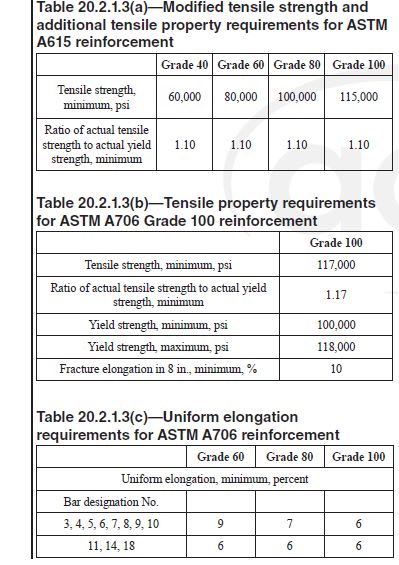GEE8B
Structural
- Apr 27, 2023
- 10
Hi all.
in Eurocode, reinforcement for concrete is classified in three groups (A, B, and C), each having a characteristic minimum tensile to yield ratio and an accompanying minimum tensile strain (measured at ultimate, i.e., the highest point on the stress-strain curve). The various available reinforcement materials are then certified to conform to these classifications, in turn defining their respective ductilities and shaping how they are allowed to be used in the design of structural elements. It is all quite intuitive.
In contrast, ACI 318 doesn’t really do this. ACI says nothing about uniform strain (i.e., strain measured at max tensile stress). Instead of having strain-based reinforcement categories, ACI 318 states which reinforcement type (as characterized by an ASTM designation) is acceptable for which structural application/usage. It works, but it just feels like there is a grey area.
When we do design by ACI here in the states, determination of tensile strain is a key step in defining whether the section qualifies as tension-controlled vs. compression-controlled or transnational, and this feeds into the phi factor used to calculate capacity. It isn’t unheard of for calculated (theoretical) tensile strains to get up into and sometimes beyond the 5% range (0.05 in/in) when doing design by ACI 318, but how do we know the reinforcement material itself, as characterized by ASTM / ACI, can actually achieve these tensile strains? Shouldn’t there be a manufacturing requirement that ensures material is meeting a certain uniform strain threshold?
I don’t doubt that most of these commonly available steel reinforcements have some internal data showing that theoretical uniform strains are being achieved (stress-strain curves would obviously show it), and I’ve seen stress-strain curves that can provide some comfort on this front. But my issue is that there is no formality to it. All that we see published in the ASTM specs (for example, A706 and A615) is a minimum elongation on a predetermined gage length measured at fracture. Yet strain at fracture is an utterly pointless attribute when it comes to engineering design of reinforced concrete.
Would ACI benefit from categorizing steels based on a formal ductility classification (as Eurocode does)?
Would love to hear your thoughts on this.
in Eurocode, reinforcement for concrete is classified in three groups (A, B, and C), each having a characteristic minimum tensile to yield ratio and an accompanying minimum tensile strain (measured at ultimate, i.e., the highest point on the stress-strain curve). The various available reinforcement materials are then certified to conform to these classifications, in turn defining their respective ductilities and shaping how they are allowed to be used in the design of structural elements. It is all quite intuitive.
In contrast, ACI 318 doesn’t really do this. ACI says nothing about uniform strain (i.e., strain measured at max tensile stress). Instead of having strain-based reinforcement categories, ACI 318 states which reinforcement type (as characterized by an ASTM designation) is acceptable for which structural application/usage. It works, but it just feels like there is a grey area.
When we do design by ACI here in the states, determination of tensile strain is a key step in defining whether the section qualifies as tension-controlled vs. compression-controlled or transnational, and this feeds into the phi factor used to calculate capacity. It isn’t unheard of for calculated (theoretical) tensile strains to get up into and sometimes beyond the 5% range (0.05 in/in) when doing design by ACI 318, but how do we know the reinforcement material itself, as characterized by ASTM / ACI, can actually achieve these tensile strains? Shouldn’t there be a manufacturing requirement that ensures material is meeting a certain uniform strain threshold?
I don’t doubt that most of these commonly available steel reinforcements have some internal data showing that theoretical uniform strains are being achieved (stress-strain curves would obviously show it), and I’ve seen stress-strain curves that can provide some comfort on this front. But my issue is that there is no formality to it. All that we see published in the ASTM specs (for example, A706 and A615) is a minimum elongation on a predetermined gage length measured at fracture. Yet strain at fracture is an utterly pointless attribute when it comes to engineering design of reinforced concrete.
Would ACI benefit from categorizing steels based on a formal ductility classification (as Eurocode does)?
Would love to hear your thoughts on this.


